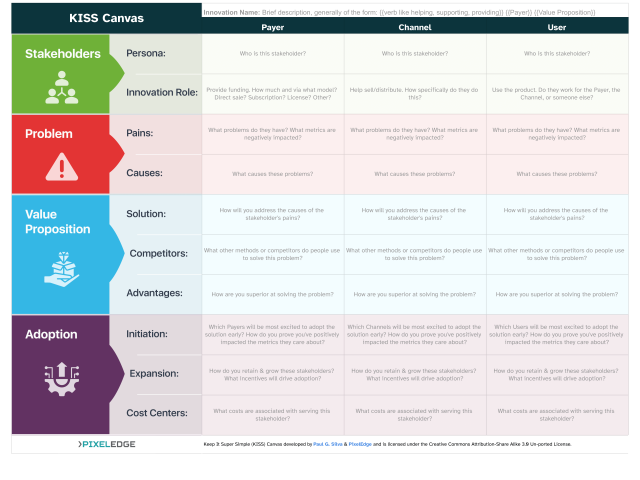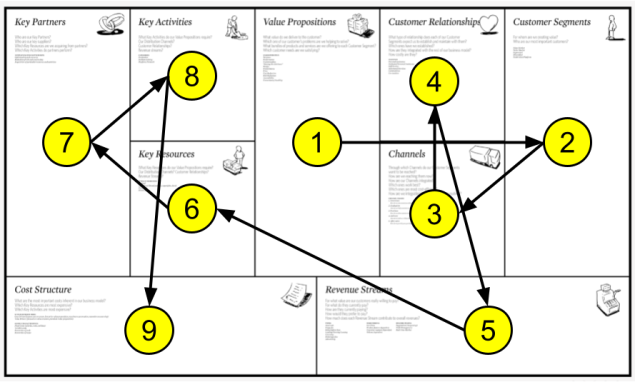![Ideas (represented by a light bulb and some origami floating around it) above a globe made of paper. [AI generated]](https://paulgsilva.files.wordpress.com/2023/12/nmviuhrwjl3skixvllda-2-59f0d.webp?w=1024)
[This is part of a series on the KISS Canvas]
For over twenty years I’ve had the pleasure of co-founding a handful of ventures and mentoring hundreds of startup and intrepreneurial teams. Over the past six years, and with great help, I’ve developed the Keep It Super Simple (KISS) Canvas to help innovators find and mitigate some of their biggest risks, from ideation to scaling. Today I’m releasing version 7, which incorporates changes to help get your innovation from idea to wide spread adoption (or what I humorously call, “benevolent world domination”).
Problem
There are a LOT of things that can go wrong in turning an idea into a successful innovation. It is very hard, in the moment, to know where to focus and when to move on. There are a lot of tools that can help, but each has limitations:
- The Business Model Canvas identifies the big picture hypotheses of your venture… but struggles to help you ID what is needed to get all your key stakeholders on board.
- A pitch deck template is great for telling a convincing story to investors, but not a practical guide for execution.
- The Founder’s Dilemmas brilliantly show you how people problems can kill your company, but doesn’t give a handy way for to quickly compare the different, and often conflicting, incentives of founders, line employees, and investors.
- The VIRAL pathway provides a great roadmap to guide truly big-picture decisions of your venture from startup to exit, but was designed for venture-backed startups and doesn’t fit well for non-venture startups or intrepreneurial innovation.
No one tool can solve all these problems or substitute for a skilled & dedicated team. However, we can do better.
Solution

The Keep It Super Simple (KISS) Canvas lets innovators take an idea from concept through to product-market-fit. Its simple guiding premise is: its all about the stakeholders. Each column represents a key stakeholder. Each row asks you a critical question to ensure success with that stakeholder. The questions cluster around: who the stakeholder is, what pains & incentives drive them, the value proposition needed to satisfy them, and how to generate adoption.
At the start of the venture, this makes it easy to document the core hypothesis that need to be tested to go from idea to launch, typically by focusing on the Payer, Channel, and User stakeholders. As you validate hypothesis, you mark them, highlighting what work is done and what is yet-to-be done. In general, a startup wants to validate from the top and work their way down.

When it comes time to craft a pitch for funders, the KISS Canvas covers 80% of a typical Pitch Deck by telling the very information investors want to know, in the order they generally want to hear it. Just add a description of why your leadership team are the right ones for the job and you’re done.
Once you’ve launched, it shows the path to product-market fit and adoption. By now you’ve likely validated the hypotheses in the Stakeholder & Problem sections, so you’ll focus on validating the hypotheses in the Value Proposition & Adoption sections.

As your venture matures and new customer segments, distribution partners, or investors become important, you simply add new columns and use the same familiar structure to document hypothesis and track progress validating.

Results
I’ve used various iterations of the KISS Canvas for years with students & clients. Some of the results I’m proudest of:
- Helped an enterprise client with thousands of employees go from idea to a deployed product tripling profit margins.
- Allowed a client who’s new product rollout was stuck to identify the problem & how to solve it. Once that was fixed, product adoption took off. The product has brought in nearly $100 million in revenue.
- Gave multiple traditional, low-tech nonprofits the structure they needed to go from idea to commercialization.
- You can find more results on PixelEdge’s recent blog post detailing how it uses the KISS Canvas to help clients.
Build your own KISS Canvas (Free!)
Below are three different formats ready-for-use. The KISS Canvas is licensed under creative commons, which means you may use or modify it freely.
Best Practices
- The column headers in the templates (payer, user, and channel) are generally, but not always, the right three to focus on at the start of a project.
- My first venture’s payers and users were the same people and we marketed directly to end users. If I was creating a KISS Canvas for that startup today, I’d use three columns, but each one would focus on a different customer segment that had distinct problems.
- The nonprofit example shown on the google sheet uses stakeholder names that are more appropriate for a nonprofit context.
- The google sheet offers dropdowns to suggest other stakeholder types you might find helpful. But feel free to make up your own!
- At the start erase every assumption about a solution from your thinking so that you can (1st) expand the universe of the potential stakeholders, then (2nd) discover all the different stakeholders’ personas, in order to determine (3rd) their primary migraine-sized pains, and then (4th) bring to bear the benefits that your solution might/must provide.
- Be clear & concise by staying within the size limit to the boxes.
- Consider everything in a box as a hypothesis waiting to be validated by actual interactions with stakeholders.
- Don’t agonize. Filling in the canvas should take about an hour. Then go test the hypotheses with stakeholders, update the canvas, and repeat as needed.
- Indicate validated hypotheses by changing their background color to be a darker shade of its original color or put a nice checkmark ✔ at the start of the cell.
How is the Simple?
A fair question :). The Simple in Keep It Super Simple (KISS) refers to a few things:
- It is simpler to use one consistent tool vs many, disparate tools. KISS vs Value Proposition Canvas + Business Model Canvas + Viral Pathway + …
- It is simpler to use a canvas that flows from top to bottom and from left to right, vs one that starts in one spot and jumps around.

- It is simpler to have different stakeholders cleanly separated in their own columns vs having different colors super-imposed on each other.

Gratitude
The KISS canvas was inspired by Alex Osterwalder’s The Business Model Canvas. Alex’s work completely changed my view on what was possible and I could not have created the KISS without his inspiration.
My great thanks to the many people who have contributed to the KISS Canvas design over the years. Some who I need to particularly call out for their awesomeness are Rick Plaut, Kelly Minton, and Liz Slavkovsky.
Thank you also to PixelEdge‘s Muhammad Awais Amjad for applying his design skills to make the canvas as attractive to look at as it is functional!
Build your own KISS Canvas (Free!)
Below are three different formats ready-for-use. The KISS Canvas is licensed under creative commons, which means you may use or modify it freely.
Pingback: A Canvas That Tells a Story: KISS Canvas (v6.0) – Paul G. Silva